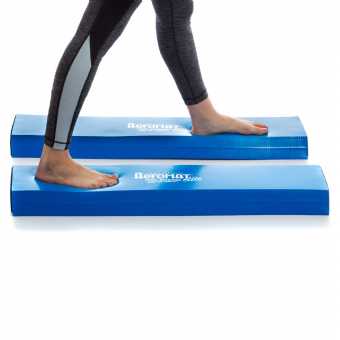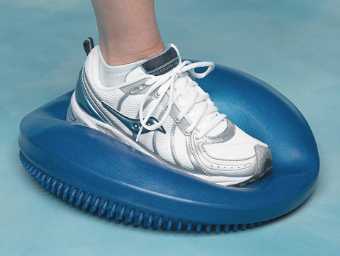












What is Balance Therapy?
Balance therapy, or vestibular therapy, is an exercise-based program that promotes compensation of the central nervous system for inner ear deficits. It can help with a variety of balance problems, such as one or both sided vestibular hypofunction associated with Meniere’s disease, vestibular neuritis, and labyrinthitis. Those with long-term unresolved inner ear disorders who have undergone medical management may benefit from these exercises. Balance therapy can also help those with an abrupt or acute loss of vestibular function after surgery for balance problems.
When the organs responsible for balance are damaged by injury or disease, the brain can no longer rely on them for correct information about motion and equilibrium. This results in vertigo, dizziness, balance problems, and other symptoms. Many people are able to recover on their own after a few weeks of normal activity because the brain has compensated for the problem. But, if the compensation process does not succeed, a person’s ability to maintain coordinated balance and posture may become overly dependent on information from the eyes, muscles and joints.
Also, they may develop new ways of head and body movement to try to avoid nausea and dizziness. For example, a person may adopt an exaggerated hip sway as a method of balancing, swiveling the whole body instead of just the head when turning to look at something, or always look down at the floor to avoid a confusing swirl of activity. However, these strategies can make balance compensation more difficult. It may even worsen the symptoms and cause headaches, fatigue, and muscle tension. The goal of balance therapy is to retrain the brain to recognize and process signals from the vestibular system in coordination with vision. This can involve desensitizing the balance system to movements that provoke symptoms.
First, a physical therapist or occupational therapist will perform an evaluation to observe and measure posture, balance and gait, and compensatory strategies. From the evaluation results, they will develop a treatment plan to be performed in the therapy setting, and at home. These exercises are designed to retrain the brain to recognize and process the signals and coordinate them with the information from the eyes and muscles.
Initially, some of the exercises may cause an increase in the symptoms as the body and brain try to sort out the new pattern of movements. Because of this, some people give up on the balance therapy, thinking it is making their disorder worse. But, in most cases, balance improves over time if the exercises are faithfully and correctly performed. Headaches, muscle tension and fatigue will go away, and the symptoms of vertigo, dizziness and nausea may disappear.
Events such as minor surgery, a bad cold or flu, or anything that interrupts normal activity for a few days can cause the brain to “forget” what it learned for compensation, and symptoms can reoccur. Most people are able to quickly recover by immediately returning to the exercise program that was developed for them. However, if symptoms are severe or persistent, it is important to go back to the doctor.
What are Dizziness, Vertigo and Disequilibrium?
Dizziness, vertigo and disequilibrium are common symptoms that are reported by adults during normal doctor visits. They are all symptoms that can result from a dysfunction of the balance organs of the inner ear (peripheral vestibular disorder) or a dysfunction of one or more parts of the central nervous system that help process balance and spatial information (central vestibular disorder). Although all three symptoms can be linked by a common cause, they have different meanings. Describing them accurately can mean the difference between a successful diagnosis and one that is missed.
Dizziness is a sensation of lightheadedness, unsteadiness, or faintness, not involving a rotational component. Vertigo has a spinning, whirling, or rotational component and is the perception of movement, either of surrounding objects or of one’s self. Disequilibrium means imbalance, unsteadiness, or loss of equilibrium that is often accompanied by spatial disorientation. Because of the many possible causes, getting a correct diagnosis can be a long and frustrating experience.
Balance dysfunction is most commonly caused by aging, head injury, and viral infections. Other illnesses may also contribute or cause balance disorders. Dizziness can be linked to a variety of problems, and is commonly correlated to blood flow irregularities from cardiovascular problems. Maintaining equilibrium and balance can be very difficult when more than one health problem exists. A mild balance disorder can be more problematic when accompanied by a visual deficit. The ability of the brain to compensate for a balance disorder is compounded when there is also a deficit with the muscles due to an injury or disease.
What are the Symptoms of a Balance Disorder?
A balance disorder can be associated with one or more of the following symptoms:
• Vertigo and dizziness
• Imbalance and spatial disorientation
• Vision disturbance
• Hearing changes
• Cognitive and/or psychological changes
• Nausea or vomiting
• Motion sickness
• Sensation of fullness in the ears
• Slurred speech
• Sensitivity to temperature or pressure changes.
How are Balance Disorders Diagnosed?
Several different kinds of tests may be required to get a thorough evaluation of the inner ear for a diagnosis. Electronystagmography (ENG) is a group of eye-movement tests that look for signs of balance dysfunctions or neurological problems by measuring a type of involuntary eye movement (nystagmus) and other eye movements. They are recorded and analyzed through small electrodes that are placed on the skin around the eyes. Rotation tests evaluate how well the inner ear and eyes work together. The examiner records eye movements while the head is moving at various speeds.
Vestibular evoked myogenic potential (VEMP) is used to evaluate if balance nerves are intact and functioning normally. Headphones are place over the ears and small electrodes are attached to the skin over the neck muscles and record the response to transmitted sounds. Computerized dynamic posturography (CDP) tests postural stability. It provides information about balance function or motor control under different environmental conditions. It measures the ability of the brain to receive sensory information from the joints and muscles.
Audiometry measures hearing function because of the close relationship between the balance organs and the inner ear. Several different audiometry tests are performed by an audiologist. A magnetic resonance imaging (MRI) exam of the brain can show the presence of stroke damage, tumors, and other soft tissue abnormalities that may cause vertigo or dizziness. A computerized axial tomography (CT) scan of the temporal bone, where the inner ear resides, is often used to look for abnormalities such as fractures. Other tests are possible, such as allergy tests or blood work to rule out causes of symptoms that are unrelated to the balance system.
Hulet Smith, OT
Rehabmart Co-Founder & CEO
lb